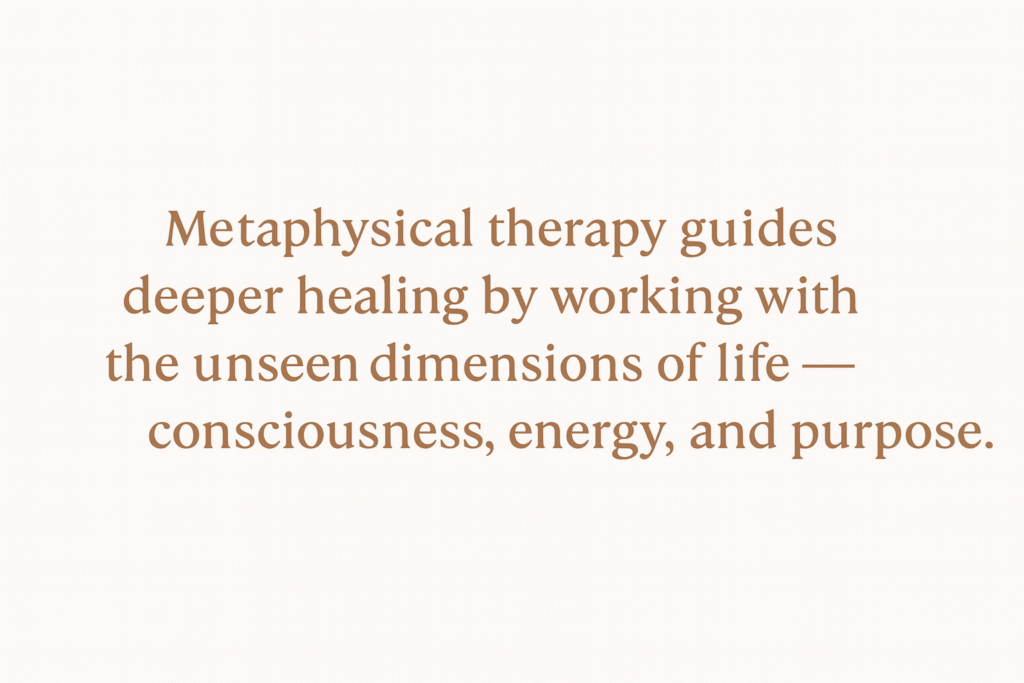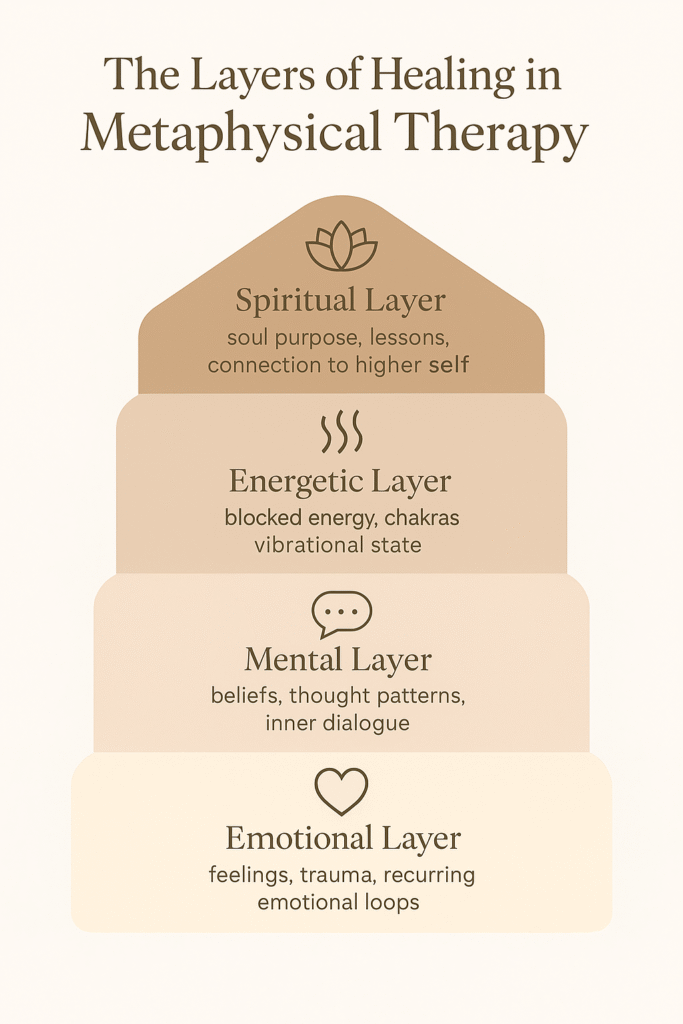Metaphysical therapy is a holistic approach that looks beyond symptoms and surface struggles to explore the deeper layers of mind, soul, and energy. While traditional therapy often focuses on behavior, thought patterns, or emotional regulation, metaphysical therapy asks bigger questions: What beliefs are shaping my reality? Where does this pain or pattern truly come from? What is my soul trying to teach me through this experience?

At its heart, metaphysical therapy is about working with the unseen dimensions of life — consciousness, energy fields, spiritual laws, and soul purpose. It doesn’t replace practical methods of healing but expands them, inviting in a more complete picture of who we are and why we experience life the way we do.
This type of therapy offers a space to step outside the purely physical or psychological lens and explore how inner reality creates outer reality. For many, it provides a bridge between therapy and spirituality — a way to understand challenges not only as problems to fix, but as lessons, catalysts, and openings for deeper growth.
Metaphysical therapy invites us to consider that healing is not only about symptom relief but about transformation. It encourages curiosity: What if the answers aren’t just in your mind or body, but in the larger patterns of your soul’s journey?
Historical and Philosophical Foundations
Metaphysical therapy has roots that stretch across philosophy, spirituality, and psychology. Its foundations lie in the recognition that reality is more than what we see, and that unseen forces — consciousness, energy, and belief — influence the human experience just as much as physical circumstances.
One of the earliest influences was the New Thought movement of the late 19th and early 20th centuries. Thinkers such as Ernest Holmes taught that our thoughts and beliefs shape our reality, a principle that continues to be central to metaphysical therapy today. This idea laid the groundwork for seeing healing not only as a physical or mental process but as a spiritual alignment with higher truth.
In the mid-20th century, approaches like transpersonal psychology began blending psychology with spirituality, exploring states of consciousness, mystical experience, and the role of meaning in human life. Around the same time, Metapsychiatry, developed by Dr. Thomas Hora, introduced the concept that human suffering comes from ignorance of spiritual reality, and that healing involves awakening to spiritual principles.
Philosophically, metaphysical therapy leans on universal concepts found in many traditions: consciousness as primary — the belief that mind and awareness precede matter; interconnectedness — the understanding that all beings and experiences are linked; and purpose and meaning — that life is not random, but filled with lessons and opportunities for soul growth.
This blending of spiritual philosophy with therapeutic practice creates a framework where healing is seen as the restoration of harmony between mind, body, and soul. It is not about adopting a single belief system, but about recognizing the deeper forces that guide human experience and opening to the possibility of transformation through them.
Core Principles & Assumptions
Metaphysical therapy is built on several guiding principles that shape both the process and the outcomes of healing. These assumptions invite us to look beneath the surface of everyday experience and consider the deeper forces at play.
Consciousness shapes reality. At the heart of metaphysical therapy is the belief that thoughts, beliefs, and awareness are not passive — they actively shape how we experience life. The quality of our consciousness influences what we perceive, how we respond, and what we attract into our reality.
Mind, body, and spirit are inseparable. Well-being isn’t limited to just the physical or emotional body. Metaphysical therapy views the self as multidimensional, where the physical, mental, emotional, and spiritual are woven together. Healing one aspect naturally influences the others.
Beliefs create patterns. Many challenges — whether recurring relationships, persistent anxiety, or feelings of lack — stem from unconscious belief systems. These beliefs, often formed in childhood or carried from cultural conditioning, act like filters on how we interpret the world. By uncovering and shifting them, new possibilities emerge.
Energy flows where attention goes. From a metaphysical perspective, our attention directs energy. When we continually focus on fear or scarcity, we strengthen those experiences. When we shift attention toward healing, love, and alignment, energy begins to reorganize in ways that support growth.
Life has purpose and meaning. Rather than seeing difficulties as random misfortunes, metaphysical therapy assumes that each challenge carries a lesson for the soul’s growth. This perspective transforms suffering into an opportunity for awakening and self-discovery.
Healing is transformation, not just symptom relief. While easing pain and stress is important, metaphysical therapy goes further — inviting clients into deeper transformation. It’s about moving from disconnection to connection, from limitation to expansion, and from confusion to clarity.

How Metaphysical Therapy Works
Metaphysical therapy blends insight, energy awareness, and spiritual practice into a process designed to uncover root causes and create lasting change. While each practitioner may adapt the method to their own style, the general flow follows a series of stages.
Awareness and intake often begin with conversation and reflection. Clients share their current struggles, life patterns, or questions about purpose. Unlike traditional intake, the focus extends beyond symptoms to include spiritual beliefs, energetic sensitivities, and the client’s sense of meaning.
Mapping the inner landscape follows, as therapist and client explore underlying belief systems, recurring emotional patterns, and the “stories” that shape perception. This stage may also include identifying energy imbalances or recurring themes that feel larger than personal history.
Releasing and clearing uses tools such as guided meditation, energy clearing, breathwork, or visualization to release what no longer serves. This often creates a sense of lightness and freedom, as old blocks begin to dissolve.
Repatterning and alignment introduce new beliefs, perspectives, and practices. The client learns to replace limiting thought patterns with affirmations, grounding techniques, or spiritual practices that foster empowerment. This stage often feels like a realignment with the Higher Self.
Integration into daily life ensures transformation continues beyond sessions. Journaling, mindfulness, energy hygiene, and rituals help new patterns take root.
Ongoing maintenance acknowledges that metaphysical therapy is cyclical rather than linear. Clients return when new challenges arise or when they feel called to deepen their growth, building resilience and a spiritual toolkit to draw on independently.
At its core, metaphysical therapy works by shifting awareness from the surface level of problems to the deeper currents of soul, belief, and energy. When awareness shifts, energy shifts — and when energy shifts, life itself begins to change.
Techniques and Modalities
| Technique | Focus | Example in Practice | Key Benefit |
|---|---|---|---|
| Meditation & Mindfulness | Calming the mind, inner focus | Guided breath awareness or silent sitting | Greater clarity and reduced stress |
| Visualization & Imagery | Subconscious exploration | Journeying to a symbolic place for healing insight | Unlocks hidden beliefs and possibilities |
| Energy Work | Clearing and balancing energy | Chakra alignment, Reiki, or breath-based release | Restores flow and vitality |
| Affirmations & Reframing | Shifting limiting beliefs | Replacing “I’m not enough” with “I am worthy” | Builds self-confidence and empowerment |
| Dream & Symbol Work | Messages from the subconscious | Journaling a recurring dream and exploring meaning | Provides guidance and deeper awareness |
| Creative Expression | Releasing and integrating | Painting emotions, dance movement, or intuitive writing | Channels healing through creativity |
| Spiritual Rituals | Anchoring intention | Lighting a candle during intention-setting practice | Creates sacred space and alignment |
| Somatic Awareness | Body–mind–spirit connection | Tracking tension during emotional dialogue | Releases stored emotions and patterns |
Metaphysical therapy draws from a wide range of practices that address not just the mind and body, but also energy and spirit. The exact techniques vary by practitioner, but they share the goal of helping clients uncover truth, release blocks, and realign with their higher self.
Meditation and mindfulness quiet the mind and open deeper awareness. Visualization and guided imagery work with the subconscious through symbolic journeys. Energy work, such as chakra balancing or breathwork, clears stagnation and restores flow.
Affirmations and belief reframing consciously reprogram limiting patterns. Dream work and symbol exploration bring forward messages from the subconscious or higher self. Creative expression — through art, writing, or movement — helps integrate insights.
Spiritual rituals, from intention-setting to simple ceremonies, anchor change in the physical world. Somatic awareness connects body and spirit, revealing where energy and beliefs are held physically and creating pathways for release.
No single modality defines metaphysical therapy. Instead, the practices weave together to meet the client where they are, offering multiple entry points into self-discovery and transformation.
Client Profile: Who It Helps / When It’s Appropriate
Metaphysical therapy can benefit people who are ready to look beyond surface-level solutions and explore the deeper meaning of their challenges. While each journey is unique, there are common themes among those drawn to this type of work.
It helps seekers of deeper meaning, people in life transitions, individuals with recurring patterns, spiritually curious clients, and those who are emotionally sensitive or empathic. It is especially appropriate during times of crisis that spark spiritual questioning, when traditional therapy feels supportive but incomplete, or for clients seeking to integrate spiritual practices into everyday healing.
Caution is important: metaphysical therapy is not a substitute for medical or psychiatric care. It may not be appropriate for individuals experiencing active psychosis, severe trauma without stabilization, or those uncomfortable engaging with spiritual concepts. Ethical practitioners set clear boundaries and collaborate with licensed professionals when needed.
Metaphysical therapy is most effective for those who are open, curious, and willing to explore how the unseen aspects of life influence their healing journey.
Ethical Considerations & Cultural Sensitivity
Because metaphysical therapy engages spiritual, energetic, and belief-based dimensions of life, ethics and cultural awareness play a central role in creating safe, respectful, and empowering sessions.
Informed consent ensures clients understand what the work entails and that it is not a replacement for medical or psychiatric treatment. Respecting belief systems honors the diverse traditions clients bring into therapy, without imposing the practitioner’s own.
Avoiding dependency protects clients from relying solely on the therapist, encouraging them instead to connect with their own wisdom. Cultural sensitivity requires avoiding appropriation and honoring practices borrowed from other traditions with respect and acknowledgment.
Integration with professional care is essential, with ethical practitioners recognizing the limits of metaphysical therapy and referring clients when necessary. At its best, metaphysical therapy holds a sacred space while empowering each client to follow their unique path.
Evidence, Research & Critiques
Because metaphysical therapy blends psychology with spirituality, it occupies a space not easily measured by traditional science. Still, research in related fields offers support.
Transpersonal psychology studies show that meditation and altered states of consciousness improve emotional regulation and well-being. Energy-based practices like Reiki and breathwork have been studied for their effects on stress reduction and physiological markers such as heart rate variability. Regression therapy research suggests improvements in quality of life and moral consciousness.
Much of the evidence is anecdotal: clients often report emotional relief, clarity of purpose, energetic balance, and spiritual growth. Critics, however, point to the lack of standardized evidence, the subjectivity of outcomes, and the potential for practitioners to impose beliefs.
Metaphysical therapy is most effective when presented as complementary, not competitive, to traditional care. It fills a gap by addressing meaning, energy, and soul — dimensions often overlooked in standard models.
Outcomes & Indicators of Progress
Metaphysical therapy defines success not just by symptom relief but by transformation. Common outcomes include emotional relief, expanded self-awareness, greater resilience, energetic balance, improved relationships, and spiritual growth.
Indicators of progress include shifts in language and thought patterns, reduced emotional reactivity, behavioral changes that reflect growth, and consistency in self-practice such as meditation or journaling. Clients may also appear lighter, more vibrant, and more connected to their sense of purpose.
Progress unfolds differently for each individual. Some notice immediate changes, while others experience gradual transformation over time. In metaphysical therapy, every breakthrough is seen as part of an ongoing journey rather than a fixed destination.
Practical Guidance: How to Engage
Engaging with metaphysical therapy begins with finding a practitioner whose approach resonates with you. Training may include metaphysical counseling, hypnosis, energy work, or formal backgrounds in psychology or holistic health. A good practitioner balances spiritual insight with ethical grounding.
Sessions typically begin with dialogue, followed by guided practices such as meditation, visualization, or energy clearing, and close with reflection and integration. Between sessions, clients may journal, meditate, practice affirmations, or create rituals to reinforce insights.
Clear intentions enhance the process. Asking yourself, What am I ready to transform? What deeper truth am I willing to embrace? sets the tone for meaningful work. Metaphysical therapy also integrates well with psychotherapy, medical care, and coaching, offering a fuller picture of healing.
Addressing Skepticism and Integrating with Other Therapies
Because it deals with consciousness and energy, metaphysical therapy invites healthy skepticism. Rather than dismissing doubt, it encourages open dialogue. Clients often wonder about scientific proof, religious affiliation, or conflicts with traditional therapy. Practitioners clarify that the work is spiritual but not religious, experiential rather than strictly empirical, and meant to complement—not replace—traditional care.
Metaphysical therapy balances rationality and spirituality, encouraging clients to filter what resonates and leave the rest. Its strength lies in integration: used alongside psychotherapy, medical care, and coaching, it deepens healing by addressing dimensions other approaches may overlook.
Metaphysical Therapy for a Successful – Happy Life
Metaphysical therapy offers more than techniques for coping — it provides a pathway for transformation. By working with the deeper layers of consciousness, belief, and energy, it helps people see challenges not as random obstacles but as opportunities for growth and soul-level healing.
This approach is not about escaping reality but about expanding it. It invites you to recognize the ways your inner world shapes your outer experience and to align more fully with your higher self. For many, this shift brings a sense of peace, clarity, and renewed purpose that traditional approaches alone may not provide.
If you feel called to explore metaphysical therapy, begin by reflecting on the questions stirring in your own heart: What am I ready to release? What deeper truth am I willing to embrace? These inquiries mark the first step toward transformation.
Healing doesn’t happen all at once — it unfolds in layers, just as we do. Metaphysical therapy simply offers the tools, guidance, and sacred space for that unfolding to happen in a conscious, empowering way.
Are you ready to step into a deeper understanding of yourself and your journey? This may be the doorway you’ve been seeking.


